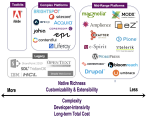What Google Plus Teaches about Publishing to Social Networks
Many web publishers have been trying to work out how best to make use of social channels such as Facebook and Twitter. It's only recently that some decent integration methods and clarity on what works have started to emerge. Now comes Google with its own social network Google+. While most people are trying to figure out how it competes with Facebook, it has also added an additional channel for web publishers.
So if you are a web publisher and want to use your Web CMS for publishing to social channels, what should you do?
Many site owners will want to press their CMS vendor or open source community to build specific integration paths to enable publishing out to these social networks. Most tools that we evaluate have at least begun to answer this call. But that's not really a scalable model in my opinion. What happens when another social network becomes hot, and you need to publish to that too? What happens -- as is often the case -- when a network changes its APIs?
Instead, you should take a step back and take a more long term approach. Out of the box integration with individual networks is fine, but insist on an integration framework that allows you to add additional social networks or channels in future. The framework should allow you to add a new external destination but also provide core plumbing services such as security, logging, exception handling and reporting in a consistent way across all social (or other) channels -- rather than one at a time.
Also remember some basics of multi-channel publishing.
Many Web CMS products provide in-context (and inline) editing capabilities that enable you to write new content within the visual context of your website. However, if you are pushing selected content to Facebook and Google+, you have multiple contexts and experiences, so you will want to think in a more agnostic way. Therefore, whenever you ask vendors to demo their slick inline editing interfaces, make sure to spend enough time evaluating the usability of their traditional, form-based interfaces. In a multi-channel world, you'll be using them more often.
You should also evaluate how the tools segregate presentation from raw content. This becomes important especially if you use rich text editors and allow your content contributors to apply styles on content. This will become problematic when published to multiple social networks. So ensure that there is a clear separation between presentation as well as content.
Your content contributors should understand that if what they write travels to multiple other channels, they really have to be more disciplined about using styles, rich text editors, and inline editing interfaces. (BTW, I could say "mobile" instead of "social" and end up with the same advice.)
Finally, remember that with growing number of external destinations where you can publish content, more than tech integrations, you need to have a true interaction strategy in place. Don't auto-publish blindly; as my colleague Tony says, "Because you can, doesn't mean you should."








